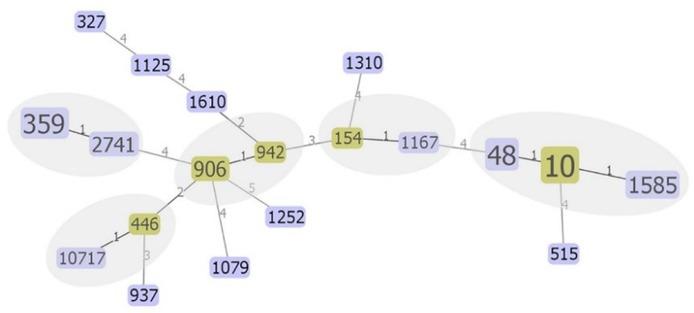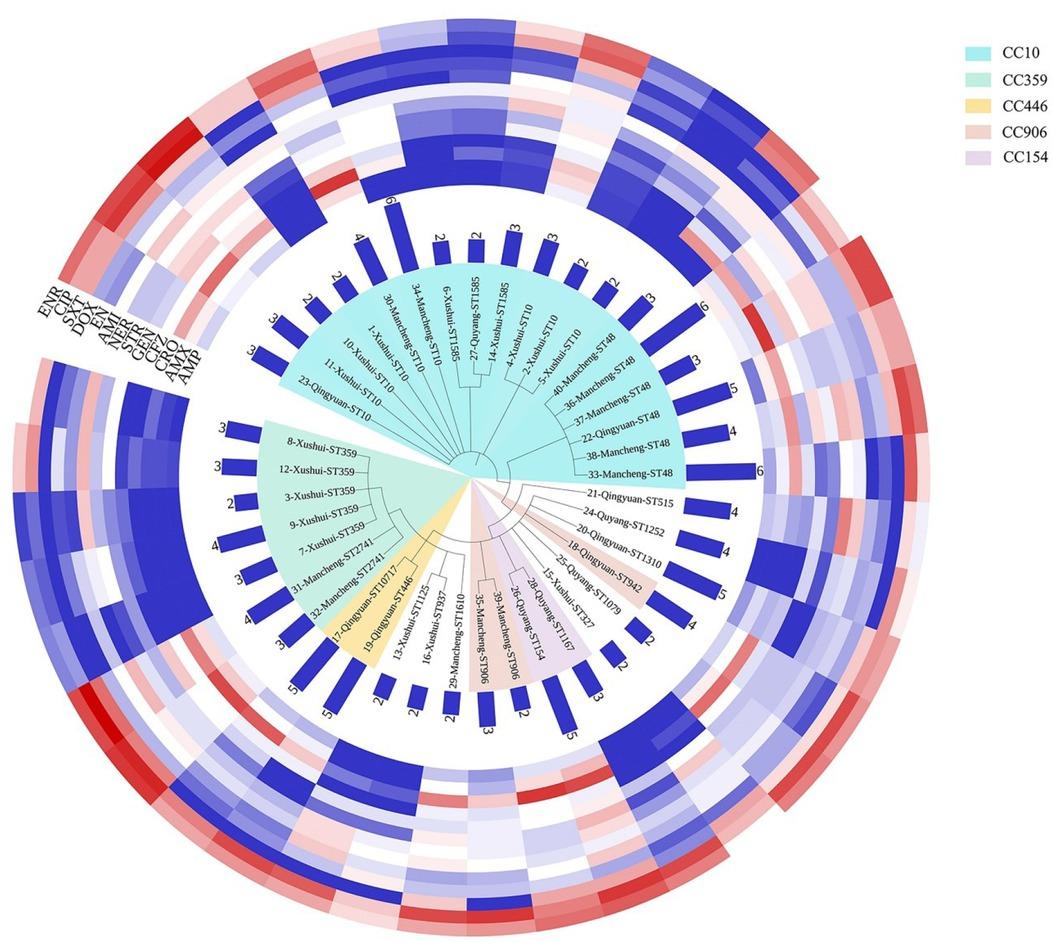Fig. 1

Fig. 2

Pearson’s correlation coefficients (r) of resistance genes and corresponding antibiotics
| Resistance gene | Antimicrobials | ||||||||||||
|---|---|---|---|---|---|---|---|---|---|---|---|---|---|
| AMP | AMX | CRO | CFZ | GEN | STR | NER | AMI | EM | DOX | SXT | CIP | ENR | |
| blaSHV | 0.231 | 0.317 | 0.333 | 0.053 | - | - | - | - | - | - | - | - | - |
| blaOXA | −0.114 | 0.248 | 0.124 | −0.059 | - | - | - | - | - | - | - | - | - |
| aac(2ʹ) | - | - | - | - | −0.27 3 | −0.12 5 | −0.083 | 0.035 | - | - | - | - | - |
| aacA4 | - | - | - | - | 0.331 | 0.035 | 0.281 | −0.053 | - | - | - | - | - |
| aadA | - | - | - | - | 0.427 | 0.353 | 0.105 | −0.059 | - | - | - | - | - |
| erm(B) | - | - | - | - | - | - | - | - | −0.04 7 | - | - | - | - |
| tet(A) | - | - | - | - | - | - | - | - | - | −0.156 | - | - | - |
| tet(B) | - | - | - | - | - | - | - | - | - | −0.347 | - | - | - |
| sul1 | - | - | - | - | - | - | - | - | - | - | - 0.174 | - | - |
| sul2 | - | - | - | - | - | - | - | - | - | - | - 0.343 | - | - |
| qnrB | - | - | - | - | - | - | - | - | - | - | - | −0.106 | 0.035 |
Susceptibility of 40 E_ coli strains to 13 antibiotics commonly used in China
| Antibiotic | Distribution of E. coli strains (number of strains/%) | Decision criteria/Diameter of inhibitory zone (mm) | ||||
|---|---|---|---|---|---|---|
| R1 | I | S | R | I | S | |
| Ampicillin | 21/52.5% | 6/15.0% | 13/32.5% | ≤13 | 14–16 | ≥17 |
| Amoxicillin | 18/45.0% | 3/7.5% | 19/47.5% | ≤13 | 14–17 | ≥18 |
| Ceftriaxone | 19/47.5% | 1/2.5% | 20/50.0% | ≤19 | 20–23 | ≥24 |
| Cefazolin | 31/77.5% | 8/20.0% | 1/2.5% | ≤19 | 20–22 | ≥23 |
| Gentamicin | 13/32.5% | 0 | 27/67.5% | ≤12 | 13–14 | ≥15 |
| Streptomycin | 12/30.0% | 5/12.5% | 23/57.5% | ≤11 | 12–14 | ≥15 |
| Neomycin | 1/2.5% | 15/37.5% | 24/60.0% | ≤11 | 12–16 | ≥17 |
| Amikacin | 1/2.5% | 1/2.5% | 38/95.0% | ≤14 | 15–16 | ≥17 |
| Erythromycin | 17/42.5% | 21/52.5% | 2/5.0% | ≤13 | 14–22 | ≥23 |
| Doxycycline | 14/35.0% | 5/12.5% | 21/52.5% | ≤10 | 11–13 | ≥14 |
| Trimethoprim- sulfamethoxazole | 22/55.0% | 0 | 18/45.0% | ≤12 | 13–16 | ≥17 |
| Ciprofloxacin | 7/17.5% | 0 | 33/82.5% | ≤15 | 16–20 | ≥21 |
| Enrofloxacin | 6/5.0% | 11/27.5% | 23/57.5% | ≤15 | 16–23 | ≥24 |
Primer sequences, product sizes, annealing temperature and references used for the PCR in the study
| Gene | Primer sequence (5′–3′) | Product size (bp) | Annealing temperature (℃) | Reference or GenBank accession no. |
|---|---|---|---|---|
| blaTEM | ATAAAATTCTTGAAGACGAAA GACAGTTACCAATGCTTAATC | 643 | 53 | (25) |
| blaSHV | TTTGTCGCTTCTTTACTCGCCTTTA GCCAGATCCATTTCTATCATGCCTA | 198 | 56 | DQ247972 |
| blaOXA | TCAACTTTCAAGATCGCA GTGTGTTTAGAATGGTGA | 591 | 53 | (25) |
| aac(2') | ACTGTGATGGGATACGCGTC CTCCGTCAGCGTTTCAGCTA | 482 | 54 | (26) |
| aacA4 | CTTCAGGATGGCAAGTTGGT TCATCTCGTTCTCCGCTCAT | 286 | 55 | (26) |
| aadA | CTGGAGGTCACTGTCGTGC CCGTGGATTGCCAAAGGTC | 274 | 55 | X68089 |
| erm(B) | AAAACTTACCCGCCATACCA TTTGGCGTGTTTCATTGCTT | 126 | 53 | MN461246 |
| erm(C) | GCTCGTGTCATTTCTGGGAGT AGCCTAGCAGCCATTTCTATC | 375 | 53 | GQ483470 |
| tet(A) | CGGAGCAGAAACAAGAAAGCG GGATCAGGACCGGATACACCAT | 345 | 57 | (26) |
| tet(B) | CATTAATAGGCGCATCGCTG TGAAGGTCATCGATAGCAGG | 391 | 53 | (26) |
| sul1 | GCCTGGAACTGCTGCTGATGC TCGCCTGCCAAACCGAACTCT | 314 | 59 | (27) |
| sul2 | GCGCTCAAGGCAGATGGCATT GCGTTTGATACCGGCACCCGT | 793 | 57 | (27) |
| qnrB | GATCGTGAAAGCCAGAAAGG ACGATGCCTGGTAGTTGTCC | 513 | 55 | (25) |
| adk | ATTCTGCTTGGCGCTCCGGG CCGTCAACTTTCGCGTATTT | 583 | 54 | (20) |
| fumC | TCACAGGTCGCCAGCGCTTC GTACGCAGCGAAAAAGATTC | 806 | 54 | (20) |
| gyrB | TCGGCGACACGGATGACGGC ATCAGGCCTTCACGCGCATC | 911 | 60 | (20) |
| icd | ATGGAAAGTAAAGTAGTTGTTCCGGCACA GGACGCAGCAGGATCTGTT | 878 | 54 | (20) |
| mdh | ATGAAAGTCGCAGTCCTCGGCGCTGCTGGCGG TTAACGAACTCCTGCCCCAGAGCGATATCTTTCTT | 932 | 60 | (20) |
| purA | CGCGCTGATGAAAGAGATGA CATACGGTAAGCCACGCAGA | 816 | 54 | (20) |
| recA | CGCATTCGCTTTACCCTGACC TCGTCGAAATCTACGGACCGGA | 780 | 58 | (20) |
Sequence types, resistance phenotypes and resistance genes in 40 E_ coli strains
| ID | Location | MLST | Resistance phenotypes | Resistance genes |
|---|---|---|---|---|
| 1 | Xushui | ST10 | AMP-AMX-CRO-CFZ-GEN-STR-EM-DOX-SXT-ENR | aadA, qnrB |
| 2 | Xushui | ST10 | AMP-AMX-CRO-CFZ-GEN-STR-NER-EM-DOX-SXT-CIP-ENR | aadA, tet(B) |
| 3 | Xushui | ST359 | AMP-AMX-CRO-CFZ-GEN-STR-NER-EM-DOX-SXT-CIP-ENR | blaSHV, aadA |
| 4 | Xushui | ST10 | CFZ-EM | aadA, tet(B), sul2 |
| 5 | Xushui | ST10 | AMP-AMX-CRO-CFZ-STR-NER-EM-DOX-SXT-CIP-ENR | aadA, sul2 |
| 6 | Xushui | ST1585 | AMP-AMX-CRO-CFZ-GEN-STR-NER-EM-DOX-SXT-CIP-ENR | aacA4, aadA |
| 7 | Xushui | ST359 | AMP-AMX-CRO-CFZ-GEN-STR-NER-AMI-EM-DOX-SXT-CIP-ENR | blaSHV, blaOXA, aadA |
| 8 | Xushui | ST359 | AMP-AMX-CRO-CFZ-GEN-NER-EM-DOX-SXT-ENR | blaOXA, aacA4, aadA |
| 9 | Xushui | ST359 | AMP-AMX-CRO-CFZ-GEN-STR-EM-DOX-SXT-CIP-ENR | blaSHV, blaOXA, aadA, tet(B) |
| 10 | Xushui | ST10 | CFZ-EM | aadA, sul2 |
| 11 | Xushui | ST10 | CFZ-EM | aadA, tet(B), sul2 |
| 12 | Xushui | ST359 | AMP-AMX-CRO-CFZ-GEN-NER-EM-SXT-ENR | blaOXA, aadA, sul2 |
| 13 | Xushui | ST1125 | AMP-AMX-CRO-CFZ-STR-SXT | aadA, tet(B) |
| 14 | Xushui | ST1585 | AMP-AMX-CRO-CFZ-EM-DOX-SXT-ENR | blaSHV, aadA, tet(B) |
| 15 | Xushui | ST327 | AMP-AMX-CRO-CFZ-EM-DOX-ENR | aadA, tet(B) |
| 16 | Xushui | ST937 | AMP-AMX-CRO-CFZ-STR-EM-SXT-ENR | aadA, tet(B) |
| 17 | Qingyuan | ST10717 | AMP-CFZ-STR-NER-EM-DOX-SXT | aac(2ʹ), aadA, erm(B), tet(A), tet(B) |
| 18 | Qingyuan | ST942 | CFZ-NER-EM-DOX | erm(B), tet(A), sul1, sul2 |
| 19 | Qingyuan | ST446 | AMP-CFZ-GEN-STR-NER-EM-DOX-SXT | aac(2ʹ), aadA, erm(B), tet(A), tet(B) |
| 20 | Qingyuan | ST1310 | AMP-AMX-CRO-CFZ-GEN-STR-NER-AMI-EM | aac(2ʹ), erm(B), tet(A), tet(B), sul2 |
| 21 | Qingyuan | ST515 | AMP-AMX-CRO-CFZ-STR-EM-DOX-SXT-ENR | aac(2ʹ), erm(B), tet(A), sul1 |
| 22 | Qingyuan | ST48 | AMP-CFZ-NER-EM | aac(2ʹ), erm(B), tet(A), tet(B), sul1 |
| 23 | Qingyuan | ST10 | CFZ-NER-EM | aac(2ʹ), tet(A), sul2 |
| 24 | Quyang | ST1252 | AMP-AMX-CRO-CFZ-STR-EM-SXT-ENR | aac(2ʹ), erm(B), tet(A), tet(B) |
| 25 | Quyang | ST1079 | AMP-CFZ-EM | tet(A), tet(B) |
| 26 | Quyang | ST154 | CFZ | aac(2ʹ), erm(B), tet(A), tet(B), sul2 |
| 27 | Quyang | ST1585 | AMP-AMX-CRO-CFZ-GEN-STR-NER-EM-DOX-SXT-CIP-ENR | aadA, erm(B) |
| 28 | Quyang | ST1167 | AMP-AMX-CRO-CFZ-STR-NER-EM-DOX-SXT | aadA, erm(B), tet(A) |
| 29 | Mancheng | ST1610 | AMP-CFZ-EM | aac(2ʹ), tet(A) |
| 30 | Mancheng | ST10 | NER-EM | aac(2ʹ), tet(A), sul1, sul2 |
| 31 | Mancheng | ST2741 | CFZ-EM | aac(2ʹ), aadA, tet(A), tet(B) |
| 32 | Mancheng | ST2741 | CFZ-EM | aac(2ʹ), tet(A), tet(B) |
| 33 | Mancheng | ST48 | AMP-CFZ-GEN-STR-EM-DOX-SXT-ENR | aac(2ʹ), aadA, erm(B), tet(A), tet(B), sul1 |
| 34 | Mancheng | ST10 | AMP-AMX-CRO-CFZ-EM-DOX-SXT-ENR | aac(2ʹ), erm(B), tet(A), tet(B), sul1, sul2 |
| 35 | Mancheng | ST906 | AMP-AMX-CRO-CFZ-EM-SXT | aac(2ʹ), tet(A), tet(B) |
| 36 | Mancheng | ST48 | CFZ-EM | aac(2ʹ), aadA, erm(B), tet(B), sul1, qnrB |
| 37 | Mancheng | ST48 | CFZ-EM | erm(B), tet(B), sul1 |
| 38 | Mancheng | ST48 | CFZ-EM | aadA, erm(B), tet(B), sul1 |
| 39 | Mancheng | ST906 | CFZ-EM | aac(2ʹ), tet(B) |
| 40 | Mancheng | ST48 | AMP-AMX-CFZ-GEN-EM-DOX-SXT | aadA, erm(B), sul1 |